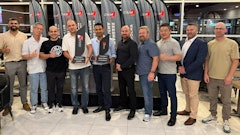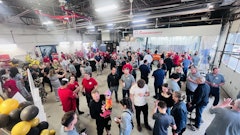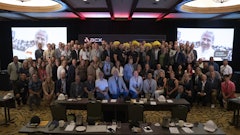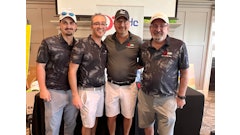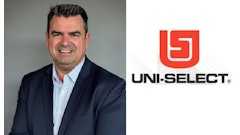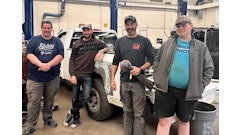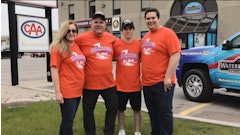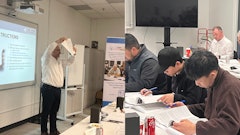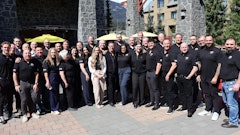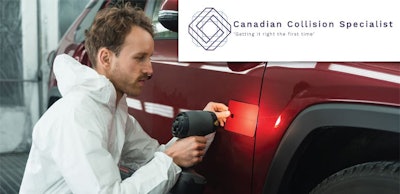
Summer colours are wonderful when they match
Column by STEFANO LIESSI
I began my career in the collision industry on the floor in the refinish department. A few years amid the lacquer putty and primer. I can still smell the sweet scent of talc. Sadly, it will be one of the scents that likely triggers me in my years of aging as I was, like many, less than cognizant of the safety protection against the harms of the materials that were the mainstay of our craft. Plumes of dust in the air from sanding and banging sanding blocks on our coveralls, to unclog the copious amounts of sanding residue, to stretch that piece of 320 that much further. Not to mention every prepper’s personal blower they had on hand to create a vortex of dust within the shop. Usually, a blower comprised of a push rod from a small block Chev brazed into a Milton fitting. Ah, the good old days.
The delayed gratification of the final shine on that perfectly prepped panel was always worth it. The time in the booth laying on those coats of beautiful colour, pouring your heart with the utmost precision—all in pursuit of that dust-free finish. To see your hard work come out the crossflow booth—the ones with the filters in the doors—while the antics of my first paragraph unfolded in front of said doors. A lot has changed over the years. There have been an incredible number of advancements in the refinish area. Amazing colours on an endless spectrum of tones, flips, shades, depths and glitters. Some of them are even matte in appearance.
First time shine is always wonderful, but what happens when it’s a collision repair with a partial finish? Today’s finishes use processes unlike anything we used to pull off in the so-called old days. The sheer variance in applications and colours were minimal then, compared to today. It was sometimes easier to match a colour—especially when many of them had the depth and appearance of a tablecloth. It was not uncommon for a painter to pull the stick out of the cup and do a quick eyeball of the colour to confirm it was good to go. On some rare occasions, a painter would do an actual spray out card, but this could turn into a lengthy process with drying times involved.
Tinting on the fly was no big challenge for many either, as we were able to ‘tint off the stick’ as we would say. And, when all else fails, add some green. Words I hold dearly from a painter I worked with decades ago as I was learning. My point is that things were, in a way, simpler back then. Today’s colours and finishes, however, are second to none. There really isn’t a bad paint line out there; and, if there is, it is short for the world.
Today’s consumer demands quality and perfection, the invisible repair that we so graciously promote is very achievable in our shops. Let’s face it, if someone was to damage my car, I want to be indemnified to the position I was prior to the incident. This includes colour match.
So, with our abilities and products coupled along with the consumer demands and warranties; why are collision centres not advancing their administration to match? Our products do not allow us to perform in the same ways anymore—nor do our process tactics. Blueprinting and spray outs go hand in hand; they are part of the process of repair, not a cost of doing business. This is a timely process to get that match correct.
Now in many cases, the chosen colour is what we call blendable—but not in every event. The paint manufacturers are faced with many challenges, as are the painters. Location of the original build, the environment, OEM contract switches, component spraying off site or at different times, spray date from factory, variations of tints from the OEM level to the different suppliers at the consumer level, 2-3-4 stage refinish, and the list goes on. When the colour is not blendable, we need to do spray outs. With today’s products, tint off the stick is no longer an option; waterborne finishes have altered that landscape making it great for the environment, but not so great for tint off the stick.
Spray-outs require time to complete and material. It’s easier as painters develop their catalogue—but you’re kidding yourself if you think you’re going to be ahead of the issues. You’re merely managing them. Time is money, and it needs to be accounted for on your admin side. If you are giving warranties and promises of invisible repairs to customers, then you must take the time to do the process correctly. We are not exactly in a period where we can just do a redo no problem—in case you’ve missed it, the increases in price of materials is way more than it ever has been.
There are a lot of factors that go into cost. Putting a cap on processes and material is ludicrous when you are expecting a oneand- done deal. Thank goodness for the paint manufacturer training that is available—that’s something that was far sparser 25 years ago. It is a great benefit to the painter to take up what they can from the supplier in effort to become that much better with the product and understand the challenges that lay ahead with matching and refinish. After all, a painter only gets one chance to get it right.
In my opinion, and you are entitled to my opinion: if you are going to be held hostage by your KPIs, then you need to account for all the processes and cost involved. Materials and matching are a small part of the equation with a big impact on your business and it’s time to have it accounted for.

STEFANO LIESSI A Red Seal technician and founder of Canadian Collision Specialist, Stefano Liessi enhances his experience with 12 years of I-CAR instructing, coupled with high school teaching to bring training that encompasses all learning types. With experience on the corporate side of the industry, as well as in management and ownership, Stefano’s focus is proper repairs and equitably for all people involved in the collision industry.





